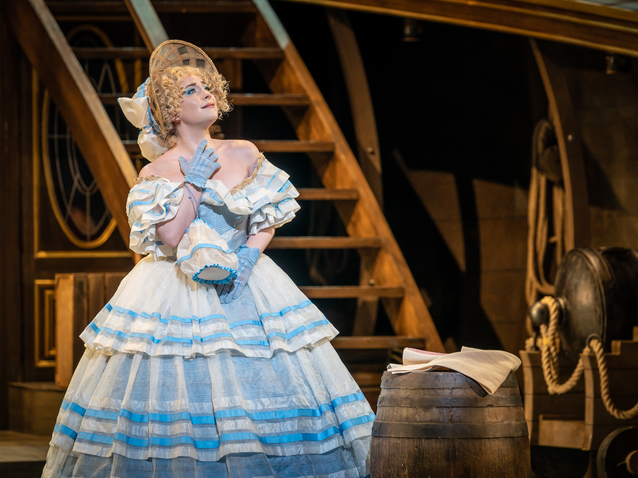 © (c) Marc Brenner
© (c) Marc Brenner
Although this is English National Opera’s first production of HMS Pinafore, it has a long and proud tradition of performing works by Gilbert and Sullivan. It is, however, a deceptively difficult task for a major opera house to pull off their creations because it is so easy for any production to fall either side of the tightrope it inevitably walks. On the one hand, these operettas require energy and so it is always a risk that top professionals in their pursuit of excellence will leave everything feeling just a little subdued. On the other, it can be all too easy to go for obvious laughs and pay insufficient attention to the works’ subtlety and dry wit. Amateur productions do not face as tough a time as we are inclined to set our expectations lower, forgive the odd bit of misplaced bravado, and most likely laugh because we know half of the people on stage. ENO enjoys no such luxuries, and its past productions have certainly met with varying degrees of success.
Jonathan Miller’s 1986 production of The Mikado, which is still going strong having last been revived in 2019, got the balance exactly right by placing the action in a 1920s hotel and achieving the highest levels of exuberance and professionalism. On the other hand, Mike Leigh’s 2015 version of The Pirates of Penzance felt a little lacking as the virtually abstract set did not help to give the drama a meaningful context when the work is all about hierarchies, though its 2017 revival felt much improved.
In 2018 Giffords Circus’s Cal McCrystal, who was the physical comedy consultant on the National Theatre’s One Man, Two Guvnors and two Paddington films, produced an Iolanthe that, by and large, was both highly amusing and respectful of the original creation. The same might broadly be said of his HMS Pinafore, although a few more obvious problems arise as it seems to take a lot longer to get going.
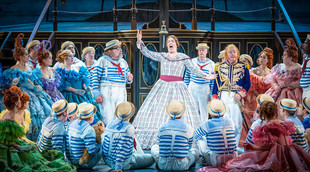
HMS Pinafore, ENO (2021) ; © Marc Brenner
The operetta itself, which premiered in 1878 and was a major hit (arguably the pair’s first), is a typical exploration of the absurd values and hierarchies that Gilbert and Sullivan saw at play in Victorian society, yet which still feel familiar today. Set aboard the eponymous ship, it sees Ralph Rackstraw and Josephine in love but unable to be together because he is a humble sailor and she the daughter of the Captain. As a result, she seems destined to marry Sir Joseph, who being based on the real life figure W. H. Smith, is First Lord of the Admiralty, despite never having been to sea. Things have a happy ending, however, when Mrs Cripps, a Portsmouth Bumboat Woman known as ‘Little Buttercup’, admits that in the past she practised baby farming and mixed up the actually high born Ralph and low born Captain Corcoran. Ralph thus becomes the Captain of the ship, paving the way for him to marry Josephine, and thwarting the best efforts of sailor Dick Deadeye, the villain of the piece, to prevent the union.
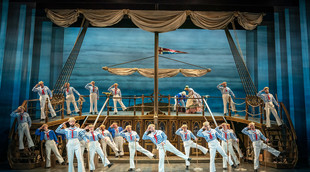
HMS Pinafore, ENO (2021) ; © Marc Brenner
In the early parts of the evening, one would be forgiven for thinking that McCrystal had decided to take an extremely different approach to HMS Pinafore than he did to Iolanthe. Whereas the laughs then were very obvious from the start, here it initially seems as if the drama is being played straight down the board. For example, takis’s set, which simply depicts the deck of a ship, looks gorgeous, but, with the exception of the Captain’s cabin swinging into view later on, remains exactly the same for the whole of Act I. The humour that is introduced feels very tame, and causes the production initially to fall between two stools. There are an enormous number of laughs to be found in Gilbert’s original lines if they are delivered entirely straight, but this production interrupts the flow of these with the addition of gags that are not funny enough to justify what they take away from the original. One cannot expect to insert an extra line before Captain Corcoran sings ‘well, hardly ever’ in ‘I am the Captain of the Pinafore’ and retain the intended timing and dry wit. By inserting another joke the beauty of the original is lost, and it feels like expecting a limerick to work with six lines. Josephine’s ‘Sorry her lot who loves too well’ is designed to hold us with its mere beauty, so Buttercup’s clumsy descent from the ship in the background during it undermines the song too much for too little reward. Even Ralph and Josephine’s ‘Refrain, audacious tar’ is marred a little because it is not led into at a sufficient pace, with the dialogue that precedes it being filled with extra lines, courtesy of McCrystal and Toby Davies.
Things improve immensely after the interval as the pace and humour are upped to levels that make Act II something of a delight. A new dimension is introduced as the ship spins around so that we see its stern from the water, and jokes aplenty flow as Little Buttercup struggles to row onto the stage, the Captain equally struggles to clamber abroad her boat from the ship, and the Midshipmite cheekily destroys the illusion that there is really any water there at all! ‘Never mind the why and wherefore’ sees Captain Corcoran, Josephine and Sir Joseph go on several tours of the ship as multiple encores abound, the performers get increasingly exhausted, cannons boom and the Midshipmite naughtily rearranges the letters of ‘HMS Pinafore’ on the stern. There is also an on-running joke regarding one of Sir Joseph’s Aunts, with the implication being that the person playing her (Flick Ferdinando) is rather confused, but as for the best jokes in the second half, it would be rather a shame to give them away.
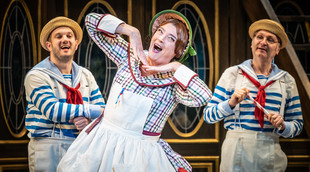
HMS Pinafore, ENO (2021) ; © Marc Brenner
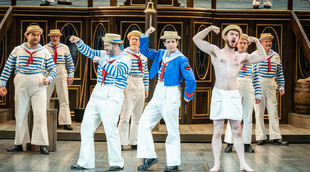
HMS Pinafore, ENO (2021) ; © Marc Brenner
Conductor Chris Hopkins gives a fine account of the score, while the cast is extremely strong. Elgan Llŷr Thomas and Alexandra Oomens deliver some beautiful singing as Ralph and Josephine, while arguably the best all-round performance comes from John Savournin whose detailed portrayal of Captain Corcoran is micro-managed right up until the moment when he instantly switches accent as soon as he is demoted. Hilary Summers is a class act as Buttercup, and if Henry Waddington’s Dick Deadeye is just a little too comical to drive home the point that, like Iago, the villain is also the cleverest character, judged by the way in which he does play it, it is hard to picture it being done better. There is also excellent support from Marcus Farnsworth as Bill Bobstay and Ossian Huskinson as Bob Becket, while Bethan Langford really stands out as Cousin Hebe, despite it being a part where that is not easy to do.
Sir Joseph Porter is played by comedian and actor Les Dennis who is, as is even referenced during the performance, not an opera singer. ENO walks a tightrope here as well, in that such a well known name can help bring in new audiences, which is always a good thing, but also risks alienating current ones. The production squares the circle well by beginning with an introduction that already makes every joke that could be made against Dennis’s involvement, leaving him then to get on with the job. Although his singing falls way short of what would be expected by ENO under any other circumstances, and he will certainly have to work hard on pacing his voice in order to see out the run, he throws himself completely into the role and overall proves an asset, rather than a liability, to the production.
This staging also introduces the role of a Midshipmite. It is shared across the run by nine-year old Rufus Bateman and thirteen-year old Johnny Jackson, with Jackson (at the performance I attended) proving immensely talented as he provides a lot of quality entertainment. In particular, he leads an extended tap dancing routine, choreographed by Lizzi Gee, at the start of Act II. This involves some trained dancers and extremely able principals, who are finally joined by the entire male chorus, and works a treat. Because it is a complete addition to the operetta, it does not undermine anything that is already there, and most importantly it sets the tone for the second half where the singing, dancing and comedy can really be found in abundance.
By Sam Smith
HMS Pinafore | 29 October – 11 December 2021 | London Coliseum
the 02 of November, 2021 | Print
Comments